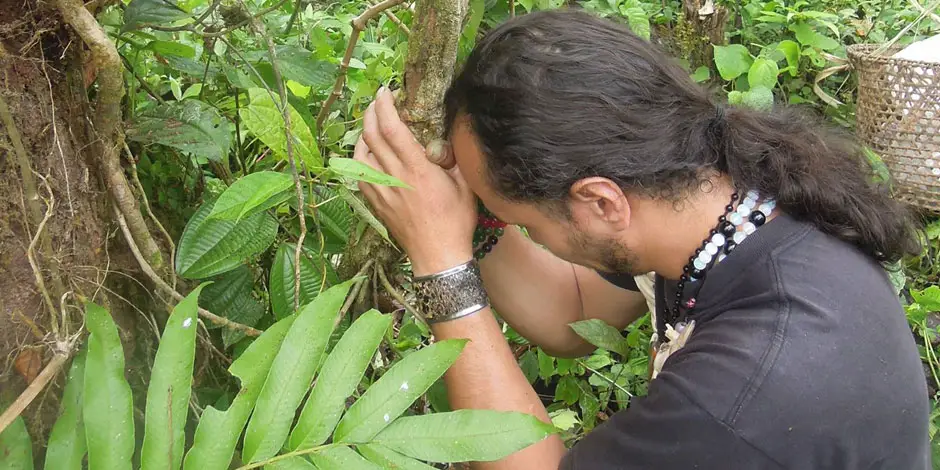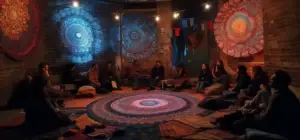Shamanism has become quite the hype lately. But how can you tell between a real shaman and a fake shaman?
In a way, recent interest in shamanism indicates increased consciousness; people are connecting with their spirituality and nature and usually helping others do the same. There’s nothing wrong with that. In fact, it can only be beneficial to those involved.
The moment this global trend towards shamanism becomes a concern and, without exaggerating, dangerous, is when a so-called shaman begins to serve medicine like Ayahuasca, San Pedro, or Kambo – to name three that we serve at Alma Healing Center.

Can I die from drinking Ayahuasca?
A common question, and one we include in our (nearly complete!) FAQ page, is “Can I die if I drink Ayahuasca?”
The answer is a resounding YES.
The analogy Taita Alejandro likes to use is the following, “You can die from drinking Ayahuasca in the same way you might die if an anesthesiologist administers too much, or too little, anesthesia. Like an anesthesiologist, the Maimas and Taitas that guide you during the ceremony are professionals. Over the course of decades, they have been learning from and administering this medicine.”
Anyone that has tried sacred plants like Ayahuasca can tell you…shit gets heavy during the ceremony. Not every time, not the first time, maybe not even the fifth time, but at some point during your relationship with Ayahuasca, you’ll fall into an abyss and experience something similar to death. That’s the point – that’s why it’s healing. Because after darkness, comes light, renewed perspective and appreciation for LIFE.
Given the potential danger involved in the Ayahuasca experience, it’s crucial to have a real shaman beside you in case you need their help.

A real shaman acts as your guide in a foreign land
During the ceremony, on a spiritual level, you might enter an unknown world and it will be a difficult place through which to navigate. Sometimes, you just can’t do it alone.
Consider this: When you’re visiting a new country and you don’t speak the language, who do you normally turn to – apart from Google Translate? That’s right, a guide. In our current self-sufficient, DIY culture, relying on a guide might provoke some distaste, but it may also reduce the chances of getting lost and robbed.
Guides show you hole-in-wall restaurants and take you to the best viewpoints so that you can appreciate the landscape from an insider’s point of view. They’re not going to be with you the entire time, only when you need them most.
Similarly, you need a guide to help you through your Ayahuasca experience and only a real shaman can do this. Maimas, taitas, and shamans are your spiritual guides, and they’re completely familiar with this spiritual territory; it is their home. If you were to get frightened during a ceremony, they’d know how to guide and help you so that you don’t get lost along the way.
Perhaps more importantly, they are attuned to the plant. They have been in deep connection with Ayahuasca since childhood. They call upon her at the beginning of the ceremony, whistling and blowing into the concoction. And when Ayahuasca takes a hold of you, pushing you beyond your capacity, it is only the maima or taita that can communicate with Ayahuasca, asking her to release her hold on you.
Three questions to ask your shaman
Given the importance of a spiritual guide during your Ayahuasca experience, how can you determine whether your spiritual guide is a real shaman, taita, maima, or yachaj runa?
(Are the terms shaman, taita, maima and yachaj runa starting to get confusing? Read the second to last section, if so.)
According to Taita Alejandro, there are three questions you can, and should, ask to determine whether you’re dealing with a real shaman:
- Which indigenous community do they represent?
- To what have they dedicated their life?
- Where do they hold their ceremonies?
1. Which indigenous community do they represent?
In the same way an accredited institution has the authority to determine whether someone is prepared to be a doctor of medicine or an engineer, only an indigenous community has the knowledge and criteria to determine who is a shaman, taita, maima or yachaj runa (see later section regarding the use of these terms).
When a community member is sick, they go to their medicinal man or woman, and he or she heals them with plants. A community only remains healthy through the support of their taita or yachaj runa and that person is, therefore, distinguished and recognized as a spiritual healer and guide.
So next time someone offers to serve you Ayahuasca, ask them, “What indigenous community do you represent?” And if they don’t represent a community, take this into consideration.

2. To what have they dedicated their life?
There are people that have dedicated 25 years of their lives to a career. Then they drink Ayahuasca twice and suddenly they’re shamans. The real taita and maima is formed from childhood. To understand the world of plants, you must begin from a young age and the real taita or mama have dedicated their entire life to this.
More frequently, people are posing as shamans and medicine men and women. In Perú and Ecuador, travelers are approached by these so called spiritual healers on every street corner, especially in Amazonian cities.
The reality is that they’re not spiritual guides at all and instead are travel agents, engineers…anything except a real shaman. Conveniently, when a group of tourists appear, they turn into solemn taitas. Ask any real shaman. This is their universe and their livelihood; they don’t dedicate their lives to anything else.

3. Where do they hold their ceremonies?
Space. Ayahuasca is medicine of the rainforest. The person in question has to have access to the adequate space to hold a ceremony. Ayahuasca isn’t supposed to be had indoors in houses or apartments; nature must be accessible and is a crucial part of the experience.
It’s like going to a lawyer with no desk, office or computer. A real shaman has a place in the jungle where they provide the medicine. Sure, they can attend to patients elsewhere, but they have their “office” or space set aside in the forest.
Shaman, taita, maima, or yachaj runa?
Shaman. People use the term shaman quite liberally to describe a spiritual healer. Interestingly, in the Amazonian spiritual path, the lowest level and most derogatory term that describes someone in the world of the sacred plants is “chaman” or “shaman”. It’s the equivalent of those sitting on a street corner reading palms or advertise magic spells and curses in a magazine.
However, it’s used widely, even by real medicine men and women in the Amazon region. The reason it’s widely used is because it’s a global term that most people will recognize. Though it isn’t even an American word and, in fact, originates from Russian. However, inter-culturally, it is widely understood.
Taita or Maima. When a person has been following the path of sacred and ancestral medicine for many years, such as 15 consecutive years. If, and only if, a plant has chosen them, they become a “Taita” or “Maima”, which mean spiritual father/mother or spiritual guide.
A “Taita” or “Maima” is someone that has taken Ayahuasca for so long and so many times that they enter the associated trance-like, meditative, state (“pinta”) without drinking the medicine.

That’s why they’re a Taita or Maima. They are so connected with the plant and have created a symbiotic relationship, which is common in the animal kingdom and in the rainforest. In this particular relationship, two beings of different species unite for a common good.
A Taita has had so much of the plant, that they can enter into the trance-like state simply by invoking the spirit of the plant.
According to Alejandro, “The meaning of Taita and Maima (spiritual father or mother) is also interesting because, when someone drinks the medicine, they aren’t even able to put there shoes on to make it to the bathroom. They often need a father or mother to help them and take them to the bathroom.”
Yachaj Runa. As you continue to grow in your spiritual path as a Taita or Maima, you eventually become a Yachaj Runa, or wise person. It takes a lifetime to become one, though all processes are different. For Taita Alejandro to reach this level, he had to live in the spiritual world of sacred plants for 21 consecutive years.
As this person continues to grow to become a Yachaj Runa, they have unified all their energy. They are no longer either a spiritual mother or father. They have unified their masculine and feminine energies to become a wise person.
If you’re with the real deal, you’re fine.
So, there you are, lying in your hammock, sick to your stomach, regretting ever having tried “the vine of the dead”. What happens next can be scary, both physically and spiritually. It can case anxiety, panic attacks, heart palpitations, fainting, extreme vomiting, and explosive diarrhea. On top of that, you’re wandering through an unknown spiritual labyrinth in the dark, Ecuadorian jungle.
Fortunately for you, if you have been careful in choosing your spiritual guide, you’ll be fine. When you feel like you need their help, you call them over, and they’ll help you. It’s as simple as that.
Drinking Ayahuaska, or any powerful plant medicine, is to be taken seriously and should be done with the utmost respect. Never drink Ayahuasca without proper guidance, (spiritual) protection and supervision.
Sign up to our email list to receive updates about upcoming retreat dates and more information about sacred plants like Ayahausca.



![Read more about the article Choosing a safe ayahuasca retreat [Updated 2024]](https://almahealingcenter.com/wp-content/uploads/2022/04/Choosing-a-safe-ayahuasca-retreat-300x118.png)